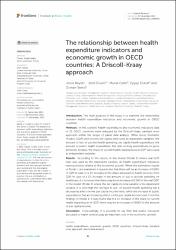| dc.contributor.author | Beylik, Umut | |
| dc.contributor.author | Çıraklı, Ümit | |
| dc.contributor.author | Çetin, Murat | |
| dc.contributor.author | Ecevit, Eyyüp | |
| dc.contributor.author | Şenol, Osman | |
| dc.date.accessioned | 2023-05-06T17:22:06Z | |
| dc.date.available | 2023-05-06T17:22:06Z | |
| dc.date.issued | 2022 | |
| dc.identifier.issn | 2296-2565 | |
| dc.identifier.uri | https://doi.org/10.3389/fpubh.2022.1050550 | |
| dc.identifier.uri | https://hdl.handle.net/20.500.11776/12022 | |
| dc.description.abstract | IntroductionThe main purpose of the study is to examine the relationship between health expenditure indicators and economic growth in OECD countries. MethodsIn this context, health expenditures and economic indicators data of 21 OECD countries were analyzed by the Driscoll-Kraay standard error approach within the scope of panel data analysis. While Gross Domestic Product (GDP) and income per capita were used as dependent variables, the amount of out-of-pocket health spending, per capita health expenditure, the amount of public health expenditure, the ratio of drug expenditures to gross domestic product, the share of current health expenditures in GDP were used as independent variables. ResultsAccording to the results, in the model (Model 1) where real GDP level was used as the dependent variable, all health expenditure indicators were positively related to the economic growth. When the estimation results of Model 1 are examined, it is predicted that there will be an increase of 0.09% in GDP in case of a 1% increase in the share allocated to health services from GDP. In case of a 1% increase in the amount of out-of-pocket spending on healthcare, it is foreseen that there may be an increase of 0.04% in the real GDP. In the model (Model 2) where the per capita income variable is the dependent variable, it is seen that the increase in out- of-pocket health spending has a decreasing effect on the per capita income level, while the increase in public expenditures has an increasing effect on the per capita income level. From the findings of Model 2, it was found that if a 1% increase in the share of current health expenditures in GDP, there may be an increase of 0.06% in the amount of per capita income. DiscussionConcludingly, it is possible to say that that public resources allocated to health services play an important role in the economic growth. | en_US |
| dc.language.iso | eng | en_US |
| dc.publisher | Frontiers Media Sa | en_US |
| dc.identifier.doi | 10.3389/fpubh.2022.1050550 | |
| dc.rights | info:eu-repo/semantics/openAccess | en_US |
| dc.subject | health expenditures | en_US |
| dc.subject | economic growth | en_US |
| dc.subject | OECD countries | en_US |
| dc.subject | Driscoll-Kraay standard error approach | en_US |
| dc.subject | panel data analysis | en_US |
| dc.subject | Public-Health | en_US |
| dc.subject | Determinants | en_US |
| dc.subject | Investment | en_US |
| dc.subject | Emissions | en_US |
| dc.subject | Impact | en_US |
| dc.title | The relationship between health expenditure indicators and economic growth in OECD countries: A Driscoll-Kraay approach | en_US |
| dc.type | article | en_US |
| dc.relation.ispartof | Frontiers In Public Health | en_US |
| dc.department | Fakülteler, İktisadi ve İdari Bilimler Fakültesi, İktisat Bölümü | en_US |
| dc.identifier.volume | 10 | en_US |
| dc.institutionauthor | Çetin, Murat | |
| dc.relation.publicationcategory | Makale - Uluslararası Hakemli Dergi - Kurum Öğretim Elemanı | en_US |
| dc.identifier.wos | WOS:000893287700001 | en_US |
| dc.identifier.scopus | 2-s2.0-85143297325 | en_US |
| dc.identifier.pmid | 36478719 | en_US |



















